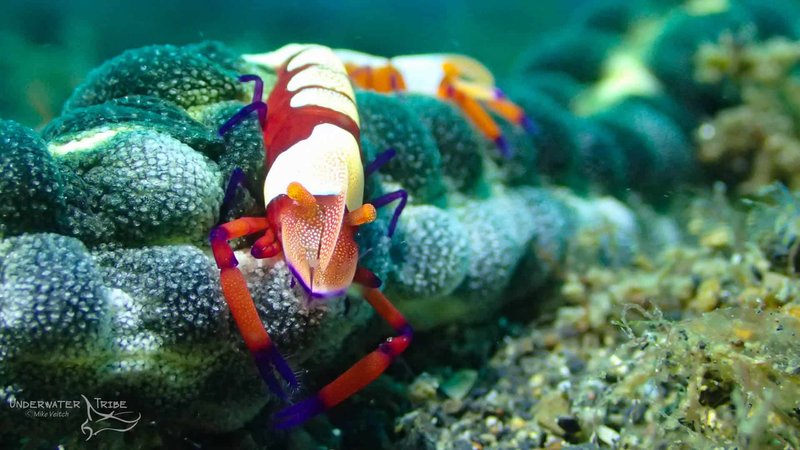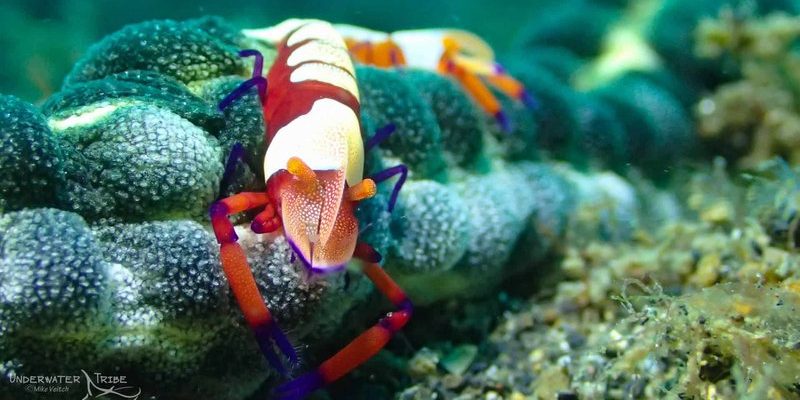
The Emperor Shrimp is one of the ocean’s most fascinating little critters. Imagine a tiny, colorful shrimp living on the back of a sea creature, almost like it’s riding on a giant underwater taxi. With its vibrant colors and unique lifestyle, the Emperor Shrimp captures the curiosity of nature lovers and ocean enthusiasts alike. But there’s a lot more to this little shrimp than just its looks!
You might be wondering what makes the Emperor Shrimp so special. These shrimp have developed a remarkable symbiotic bond with certain species of sea cucumbers and anemones. This means they live closely with other sea creatures, benefiting from the relationship while also providing help in return. It’s like a small-town collaboration—each party has its role, and together, they thrive.
Physical Characteristics
The Emperor Shrimp is known for its stunning appearance. Measuring around 2 to 4 centimeters in length, they boast bright colors that can range from orange to red, often with stripes or spots. Their lively hues are not just for show; these colors can help them blend in with their host animals, keeping them safe from predators. Imagine a tiny, orange-and-red striped hitchhiker, camouflaged perfectly against a sea cucumber’s textured surface.
One notable feature of the Emperor Shrimp is its body shape. The shrimp has a compressed body, which helps it navigate its surroundings and cling effectively to the host it resides on. Their long antennae assist in sensing their environment, allowing them to detect potential threats. This small adaptation is vital for survival in the bustling underwater world.
Habitat and Distribution
Emperor Shrimp can be found in warm tropical waters, often in the Pacific and Indian Oceans. They tend to prefer shallow reefs and sandy bottoms, where they can easily find their sea cucumber or anemone host. These shrimp are incredibly adaptable, making home in various environments, as long as they can find a cozy spot on their preferred host. You might stumble upon them in places like the Great Barrier Reef or the waters surrounding Indonesia.
Interestingly, the Emperor Shrimp often changes its residence as it matures. Juveniles might live on different hosts than adults, allowing them to maximize their survival chances. This is similar to how kids might move from one neighborhood to another as they grow up, always looking for the best place to play and grow.
Diet and Feeding Habits
When it comes to food, the Emperor Shrimp is primarily a scavenger. They feed on tiny particles, algae, and detritus that float by in the water. Think of them as little vacuum cleaners, diligently cleaning their environment while getting their meals in the process. Their feeding habits are also a part of their symbiotic relationship. By consuming leftover debris and parasites from their host, they help keep their host healthy.
This mutual benefit is key in the underwater ecosystem. The shrimp not only get a free ride but also a steady source of food. In exchange for a safe home and a good meal, the shrimp contribute to the cleanliness and health of their host. It’s a lovely little arrangement that showcases the beauty of nature’s interconnectedness.
Behavior and Social Structure
Emperor Shrimp are typically solitary creatures. However, they can sometimes be spotted hanging out in small groups on a host. This behavior can be likened to how friends gather together at a favorite café. They enjoy each other’s company but also cherish their independence. Each shrimp has its territory on the host, where it feels secure and free to explore.
When feeling threatened, Emperor Shrimp often display a unique behavior—they will quickly retreat into the crevices of their host, making them hard to spot. Their ability to hide when necessary is a crucial survival skill in a world filled with potential predators. You might find it amusing to think of them as shy, colorful little ninjas of the sea.
Reproduction and Lifecycle
The reproductive process of the Emperor Shrimp adds another layer to its complex life. During mating seasons, males will engage in colorful displays to attract females. Once mated, females will lay hundreds of eggs, which they carefully protect. These eggs are often attached to their host, where they benefit from the host’s protection as they develop.
After several weeks, the eggs hatch into larvae, which drift in the ocean currents before eventually settling down and finding a suitable host. The journey from larva to adult is a classic tale of adventure, as each shrimp embarks on a quest to find its place in the world. Think of them as young adults venturing out to find their first apartment!
Conservation Status
Currently, the Emperor Shrimp is not classified as endangered. However, like many marine species, they face threats from habitat loss, pollution, and climate change. Coral reef degradation and ocean temperature changes can disrupt their ecosystems, impacting their populations. It’s like witnessing your favorite café close down—sad and concerning!
Conservation efforts aimed at protecting marine habitats are crucial for the survival of species like the Emperor Shrimp. Every little action counts, from reducing plastic waste to supporting marine conservation initiatives. When we take a moment to appreciate these colorful little shrimp, we also recognize the importance of protecting their underwater homes.
Interesting Facts about Emperor Shrimp
| Size: | 2 to 4 centimeters |
| Habitat: | Tropical and subtropical waters |
| Diet: | Detritus, microalgae, and parasites |
| Color: | Bright orange, red, and striped |
| Lifespan: | Up to 3 years |
| Behavior: | Solitary but can form small groups |
FAQ
What is the scientific name of the Emperor Shrimp?
The scientific name for the Emperor Shrimp is Periclimenes imperator. This name reflects its distinguishing features and behavioral traits. The “imperator” part of the name hints at its regal appearance that stands out in its environment, making it a subject of interest for both researchers and marine enthusiasts alike.
How long do Emperor Shrimp live?
Emperor Shrimp typically have a lifespan ranging from 2 to 3 years in the wild. Various factors can affect their longevity, including environmental conditions, availability of food, and the presence of natural predators. In a safe and healthy habitat, these shrimp can thrive for their full lifespan, continuing their crucial role in the ecosystem.
Are Emperor Shrimp good for aquariums?
Yes, Emperor Shrimp can be a delightful addition to marine aquariums! Their vibrant colors and unique behaviors make them visually appealing. However, they require specific conditions to thrive, including a well-maintained environment and compatible tank mates. Ensuring that there are suitable hosts for them to cling to, like sea cucumbers, can help mimic their natural habitat.
How do Emperor Shrimp communicate?
Emperor Shrimp communicate primarily through chemical signals and body movements. Their long antennae help them detect changes in their environment, which can signal the presence of danger or potential mates. They can also use subtle body positioning to indicate comfort or stress levels in their relationship with their hosts.
Can Emperor Shrimp change color?
While Emperor Shrimp do not dramatically change color like some other marine animals, their bright coloration can vary slightly based on their environment and health. Healthy shrimp usually display vibrant hues, whereas stress or illness may dull their colors. This serves as an important visual cue for their well-being.
What do Emperor Shrimp eat in the wild?
In their natural habitat, Emperor Shrimp primarily consume detritus and small particles of organic matter suspended in the water. They also feed on parasites and leftover food from their host animals. This scavenging role is vital in helping maintain the ecosystem’s health, demonstrating their valuable contribution to marine life.
Do Emperor Shrimp have any natural predators?
Yes, Emperor Shrimp are vulnerable to various predators in their environment, including fish, larger shrimp, and other marine animals. Their bright colors serve as both camouflage and a warning signal to potential predators, indicating that they are living among the protective bodies of their hosts. This relationship offers them critical protection against being eaten.
How do Emperor Shrimp choose their hosts?
Emperor Shrimp choose their hosts based on various factors, including the host’s size, health, and habitat. They prefer healthy sea cucumbers and anemones where they can find shelter and food. When looking for a host, the shrimp assess the environment around them to ensure they pick a spot that maximizes their chances of survival.
Are Emperor Shrimp social animals?
While Emperor Shrimp are generally solitary, they can sometimes be seen in small groups, especially when living on larger hosts. This behavior suggests that they might enjoy some social interactions but still maintain personal space. Their interactions can be likened to friendly acquaintances who cross paths occasionally but ultimately prefer to do their own thing.
Can I find Emperor Shrimp in aquaculture?
Emperor Shrimp are not commonly found in aquaculture due to their specific habitat requirements and dietary needs. However, they hold great value in marine ecology, making them a species of interest for conservation efforts. When maintained in controlled environments, such as aquariums, their care should mimic their natural habitat as closely as possible to support healthy growth.
What is the role of Emperor Shrimp in the ecosystem?
Emperor Shrimp play a crucial role in their ecosystem as scavengers, helping clean up debris and parasites while promoting the health of their host animals. This mutualistic relationship benefits both the shrimp and their hosts, contributing to a balanced marine ecosystem. Their presence adds diversity and vitality to coral reefs and surrounding habitats.
How can I help conserve Emperor Shrimp populations?
Supporting marine conservation efforts is key to protecting Emperor Shrimp and their habitats. You can help by reducing plastic use, participating in beach cleanups, and supporting policies aimed at preserving marine ecosystems. Educating others about the importance of these tiny creatures can also make a significant impact, ensuring that they thrive for generations to come.

